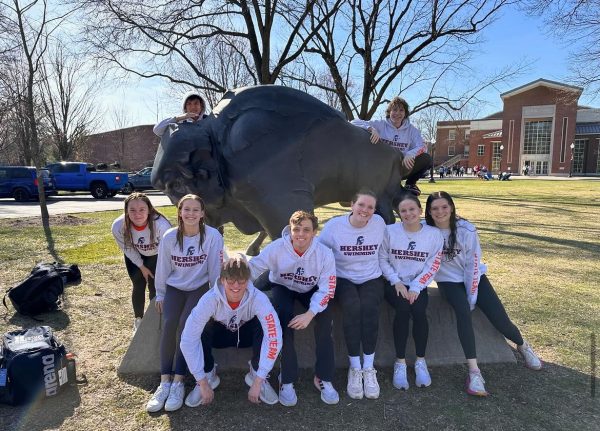Schools Continue to Increase Monitoring of Students’ Social Media
October 16, 2018
Schools throughout the country are beginning controversial practices, yet most people remain unaware that this is an issue.
As technology usage develops both in and outside of the classroom, schools have adopted methods of monitoring and tracking students online. This mostly includes access to students’ social media posts that extends after school hours and off school grounds. Some students have even speculated that this has reached Hershey High School.
Traci Landry, the Director of Instructional Technology at Derry Township, said the issue isn’t very pressing right now.
“We like to focus and promote [social media] rather than tracking. We haven’t had that need like other districts have,” said Landry.
When it comes to social media, there isn’t much urgent concern, Landry said. Teachers and students alike have both displayed appropriate and positive usage of social media, according to Landry.
However, other schools districts in the U.S. have utilized social media monitoring in order to address specific issues. The goal is to catch mental health problems early on and even prevent situations like school shootings.
According to the New York Times, “more than 100 public school districts and universities, faced with the prospect that the next attacker may be among their own students, have hired social media monitoring companies over the past five years.”
There is still minimal evidence to suggest whether these methods work. Instances have been reported where students were suspended or expelled after displaying what a school may deem as inappropriate social media usage. However, there is no official or reliable support for social media monitoring.
The accessibility is contributing to the spread of social media monitoring. As schools attempt to increase preventative measures, the lower prices and availability of monitoring services become an appealing option.
The New York Times also stated that “because of their relatively low cost — contracts typically range from a few thousand dollars to $40,000 per year — the deals can get buried in school board agendas.”
Whichever platform a school chooses to collect data, it is usually constricted to specific information. Monitoring companies look at sites like Twitter, Instagram, and Facebook for words or phrases that could signify dangerous situations.
Although the utilization and sharing of data isn’t definitive for each school, it is understood that schools can access public information. Legal analyst Jack Ford from CBS News explained that schools can legally track students’ online if they are posting publicly.
Companies like Social Sentinel and Firestorm offer monitoring services to schools and have confirmed this. They reiterate that they only enable schools to access whatever is publicly available. They also don’t intentionally seek out individuals.
Another question raised about monitoring includes whether these services can determine what is inappropriate. It is not always clear if companies can yield the accurate type of data. Algorithms used aren’t guaranteed to completely process the things students post, especially since the context may change outside of school.
Social media monitoring creates a discussion of when privacy rights apply. The Washington Post said that “while students’ privacy and free speech rights may be diminished when using school Wi-Fi networks and school-issued devices, social media monitoring extends into their out-of-school social and recreational lives.”
Those in support of monitoring have expressed that each school will need to set specific procedures and policies when dealing with this practice. The act of monitoring students must be handled as delicately as possible. In general, the prevalence of technology demands consistent evaluation for most schools, including HHS.
While Hershey hasn’t begun social media monitoring, other types of online involvement still apply. An expectation of privacy is limited on school issued devices which are controlled by the technology department. This is done in a variety of different approaches.
One example of this is the online access available on school iPads. Landry explained that, by law, we need to filter the wifi students receive.
Every school device has an address on it which identifies the student. The identification is used to determine what kind of filtering policy the device will receive. For example, grade level is a large determining factor. Seniors may have a different filter than freshmen.
With the heavy presence of technology, the school has evolved in the way they handle it. David Sweigert, the DTSD Director of Infrastructure Technology, explained that in past years, the district used a mechanism that enabled them to see each keystroke entered into a device.
Adjustments with managing technology are made each year. If the demand for social media and online monitoring ever arose, the issue would be addressed thoroughly by the school.
Currently, social media monitoring is not a concern at Hershey. “If the district identified it as a need, that would be an administrative discussion,” said Landry.




